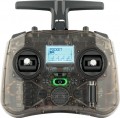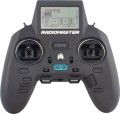Suitable for
—
For copters (FPV drones). Controllers for controlling unmanned aerial vehicles - quadcopters, multicopters and FPV drones (with first-person view). The entire functionality of the drone rests on the shoulders of the remote control: moving in the air, maneuvering, transmitting a video signal from the camera, etc. Quadcopter controllers typically have knobs, levers, or buttons that allow the pilot to control the drone's movement. In addition, the remote control can be equipped with various switches and controls for other functions (activating the camera, turning on the autopilot, and much more).
—
For helicopters. Control equipment for RC helicopters. When choosing such a controller, preference should be given to multi-channel remote controls (see “Number of channels”) - this is important for flexible control of all movements of the helicopter in the air (acceleration, climb, flight direction, rolls, auxiliary functions for switching various model options) .
—
For airplanes. Control controllers for aircraft models - airplanes, biplanes, flying wings. Such remote controls are assigned the functions of adjusting flight altitude, aircraft speed, changing flight direction using ailerons, flaps, etc. In advanced aircraft models, the controller can be used to control engine starting, landing gear extension and other advanced functions.
—
For gliders. Controllers for controlling the flight functions of gliders - aircraft models with a large wingspan (it can be more than 2 times the length of the fuselage). Radio-controlled gliders are equipped with engines, but due to the characteristics of the wing, constant operation of the engine is not required for stable flight - it is supposed to be started and “switched off” from the remote control, as well as to control other aspects of the flight.
-
For cars. Devices and devices used to control the movement of model cars, buggies, truggies, crawlers and other RC vehicles. The remote control for such self-propelled vehicles usually contains handles, levers or joysticks that control various aspects of the model's movement. The functionality of car controllers often includes control of speed, direction, braking and other additional functions (for example, turning on headlights or sound effects in some models).
—
For special equipment. Remote controls for large and “heavy” special equipment using radio control. This category includes buses, trucks, tractors, excavators, cranes and other models. The specificity of such controllers is often tied to expanded functionality, because in addition to banal movements, it is important to take into account the special capabilities of special equipment - control of the operation of lifting mechanisms, buckets, bodies for transporting goods, etc.
—
For boats. Controllers for radio-controlled water transport - boats, yachts, submarines, catamarans, jet skis. Remote controls for such models allow you to control the movement of the boat and additional functions such as turning on/off the camera, lighting or sound effects.
Form factor
-
Gamepad. Remote controls in the gamepad form factor are supposed to be held with both hands. The controls in them are represented by buttons, levers, etc. The control elements are placed in such a way that they can be conveniently reached without changing (or almost without changing) the grip.
—
Rectangular (box). Advanced controllers for controlling RC models usually have a rectangular or almost square shape. This category includes both remote controls with a screen that occupies the lion’s share of the front part of the controller body, and models with an extensive set of control elements for maximum control of all parameters. Such remote controls are supposed to be held with both hands. Often their design includes a service display for telemetry (see “Telemetry support”).
—
Motion controller. Controllers for controlling the RC model using gestures and body movements. In most cases, they are devices held in the hand. Such remote controls have buttons and other traditional controls, but it is the movements tracked by the manipulator that play an important role. The action of the motion controller is often based on the use of mechanical sensors - an accelerometer and a gyroscope, but some models may include special additional equipment to improve accuracy.
—
Pistol. Remote controls of this form factor are h
...eld in the hand like a pistol—hence the name. In the overwhelming majority, such controllers are designed to control RC machines, special equipment and boats. The gas trigger in pistol controls is usually placed under the index finger, and on the side of the body there is a ring that is responsible for turning the RU model. These organs can be supplemented with other elements to control auxiliary functions.Firmware
Open source firmware for RU-model radio transmitters. They are supposed to be used for piloting drones, model airplanes and helicopters. Currently, the following options are widespread:
-
OpenTX. Software firmware with wide capabilities that allows you to flexibly configure various controller control parameters: channel functions, feedback, switch logic and much more. OpenTX has a large community of users and developers, ensuring continuous development and support of the firmware.
-
EdgeTX. A fork from the original OpenTX firmware (see above), released to introduce new features. Thus, EdgeTX debuted touch screen support on transmitting equipment, and in general the firmware offers a more intuitive user interface. EdgeTX provides advanced RC customization options for quadcopters.
—FreedomTX Firmware based on OpenTX and EdgeTX (see relevant paragraphs), but with its own unique features. In particular, its main goal is to create open source software for radio control, which is completely free from any restrictions of patents and licenses. FreedomTX strives to provide complete freedom and independence from the external framework provided with drone remote controls.
Controls
The total number of controls in the remote control directly depends on the design, manufacturer, model and, most importantly, the purpose of the controller. This paragraph specifies all switches, buttons, sticks, sliders, scroll wheels and other elements used to control the RC model.
Gimbal adjustment
Adjustment of gimbals (sticks) in remote controls for RC models is usually carried out at the physical level. This could be changing the angle of deflection of the levers, replacing or tensioning the springs to adjust the sensitivity, adjusting the tips to increase the speed of the suspension's response to control commands. In practice, such adjustment helps to optimize the behavior of the RC model in accordance with user preferences.
In the box
—
Cover/case. Case for storing and transporting the controller. Cases are called soft cases - they are designed mainly to protect against dirt. Cases are made of hard materials - they are more bulky, but they are able to protect the remote control from impacts and shocks.
—
Protection of gimbals/sticks. Protective covers or casings that cover the controller's control elements (in particular, sticks) and prevent them from being accidentally pressed. Such devices will come in handy for safely storing and carrying the remote control.
—
A set of springs for suspensions. These controller gimbal kits typically come with several different spring options, allowing you to select the appropriate control stiffness based on the user's individual preferences. This provides greater flexibility and the ability to customize the control panel to suit specific needs and conditions of use.
-
Protective glass. Glass or transparent film to protect the remote control screen from scratches, dirt and mechanical damage. Protective glasses are tasked with keeping the controller display in good condition. This is especially important on models with touchscreens or color TFT panels, where scratches or damage can negatively affect the quality of the information displayed.
Power supply
Types of batteries from which autonomous operation of the remote control is established.
Many controllers can receive the necessary power from a built-in battery. It comes immediately with the remote control, and the user does not have to constantly buy fresh batteries - the battery is supposed to be recharged as energy reserves are depleted. One of the disadvantages of this option is the impossibility of quickly replacing batteries - charging the battery takes some time.
In models powered by replaceable elements, it is possible to quickly replace dead batteries with fresh ones and continue working with the controller. In addition, there are many brands of batteries on the modern market, so you can select specific elements at your discretion. And it is best to buy elements in the form of rechargeable batteries - very often controllers are powered from such batteries. Moreover, there may not be batteries included in the kit, but many remote control models allow the possibility of charging them. If you purchase several sets of spare batteries, interruptions in using the controller are reduced to almost zero.

